47 - Jesse Haston, Missouri Pioneer With 3 Wives & 21 Children
Part 1 - Until the Civil War
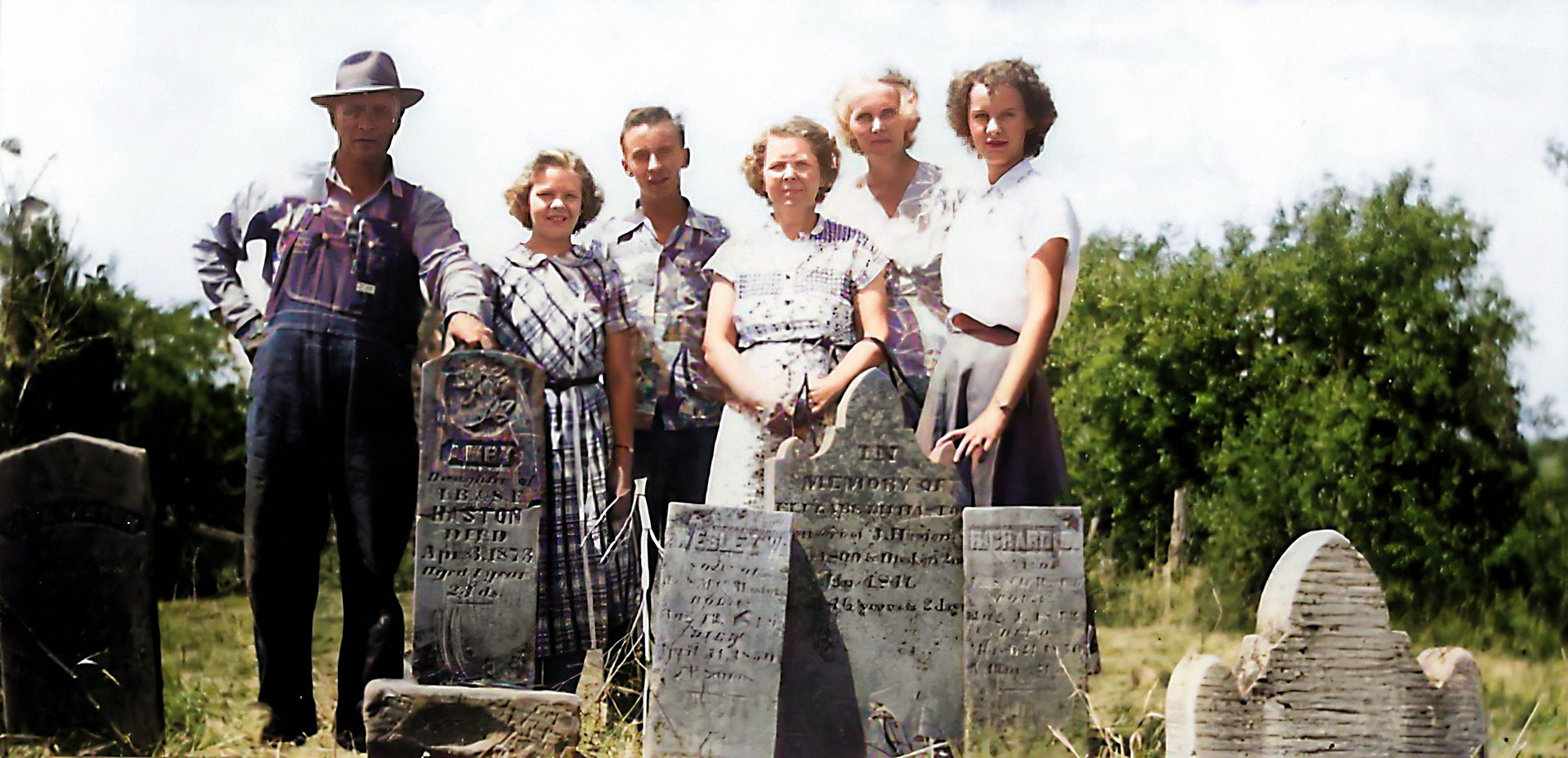
Of Daniel Haston’s sons, Jesse was the most unique in several ways. He was the first son to move west of the Mississippi River. He was a slave owner. He became a wealthy man, by local standards. He had three wives and 21 children. And he was the only son of Daniel who was murdered.
January 2, 1796 – According to Jesse Haston’s tombstone, he was born on this date. If, as I suspect, the 1796 date for Jesse’s birth is correct, he was very probably born south of the Holston River, “opposite Knoxville,” in Knox County, Tennessee.
As the title says, he had three wives and 21 children. No, he wasn’t married to all three of them at the same time. Unfortunately, his first two wives died before he did.
First Wife: Elizabeth Gillentine
Jesse married Elizabeth Gillentine. Nicholas and Jane Elizabeth Terry Gillentine were neighbors to Daniel Haston’s family in the early years of White County. Nicholas Gillentine was a prominent civic leader in White County and a leader in the Big Fork Baptist Church, which was located about one mile from the Daniel Haston homestead.
December 5, 1800 – According to her brother’s (John Gillentine’s) Bible record, Elizabeth was born on this date. Another record by a family researcher gives her date of birth as February 4, 1801, so who knows for sure?
December 12, 1815 – Without stating a source, Howard H. Hasting, Sr. recorded that Jesse married Elizabeth Gillentine on December 12, 1815. If correct, this would have meant Elizabeth was just over 15 years old when she married, which was not uncommon at that time.
Thirteen of Jesse’s 21 children were born to Elizabeth.
Child | Birth | Death |
Jane Haston | February 15, 1817 | |
Polly/Mary Haston | October 16, 1818 | June 13, 1819 |
James A. Haston | October 2, 1819 | January 1, 1820 |
Missouriana Haston | December 18, 1820 | December 26, 1864 |
William Asbury Haston | April 10, 1823 | August 1893 |
Abi Alburn Haston | May 6, 1825 | April 8, 1917 |
Nicholas G. Haston | July 27, 1827 | September 1, 1857 |
Ann Eliza Haston | December 5, 1828/29 | December 15, 1849 |
Mandy Melvina Haston | October 1, 1832 | |
Thomas Jefferson Haston | August 6, 1834 | 1889 |
Elizabeth Haston | June 30, 1838 | |
Jesse Haston | March 10, 1841 | September 1896 |
Isaac B. Haston | December 27, 1842 | September 9, 1890 |
1818 – The 1894 biographical sketch for Jesse Haston, Jr. (son of the Jesse Haston of this chapter) states that the elder Jesse Haston moved to Missouri from east Tennessee in the year of 1818. With regard to Missouri in 1818, the “when the people of that State had still to live in forts to protect themselves from the Indians” phrase is particularly interesting.[i]
[i] Joaquin Miller, An Illustrated History of The State of Montana, (Chicago, IL: The Lewis Publishing Company, 1894), 403.

March 31, 1820 – There were two letters for Jesse Haston remaining in the Post Office at Franklin of the Missouri Territory.[i] Franklin is located in the southcentral part of Howard County, approximately 20 miles southeast of Glasgow, Missouri where Jesse later settled. Apparently Jesse was already in Missouri at this time or his folks back home expected him to be there.
[i] “List of Letters,” Missouri Intelligencer (Franklin, Missouri), April 22, 1820, 4.

August 10, 1821 – The area that became Missouri was a part of the Louisiana Purchase Treaty of 1803. On July 4, 1805 it became an organized incorporated territory, the Louisiana Territory. On June 4, 1812 it was renamed the Missouri Territory. Prior to Jesse Haston’s arrival in Missouri, a petition requesting statehood was circulated in Missouri in 1817.
Statehood for Missouri became more difficult than the 1817 Missourian petitioners imagined. By 1820 Missouri had enough inhabitants—more than 70,000—to become a state. A thirteen-county area (including where Jesse lived) of central Missouri came to be called Little Dixie but was more akin to Virginia than the Deep South.[i] The southern influence in Missouri, not only in Little Dixie, complicated the territory’s path to joining the United States. Finally, on August 10, 1821 President Monroe issued the following statement: “The admission of the said State of Missouri into this Union is declared to be complete.”[i]
[i] Meyer, 157.
[i] David Hackett Fischer and James C. Kelly, Bound Away: Virginia and the Westward Movement. (Charlottesville, VA: University of Virginia Press, 2000), 178.
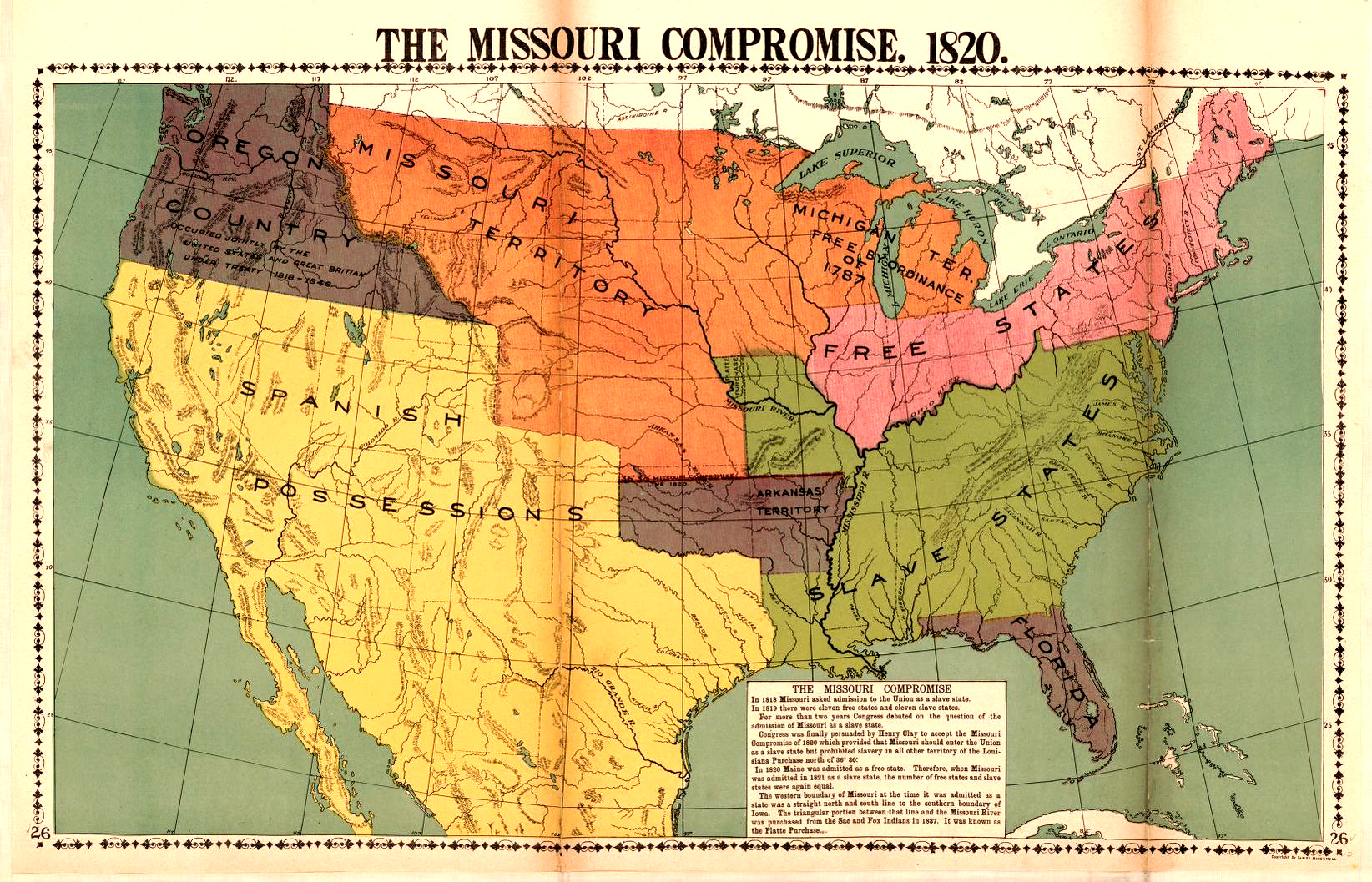
Mexican War, 1846-1848
Missourians took a special interest in the Mexican-American War. Despite the blustering of Missouri Senator Thomas Benton that men from his state could win the Second Seminole War (1835-1842) if only given the chance, 450 of the 600 Missourians in that war deserted or were discharged. Consequently, “the charges of cowardice refused to dissipate and left a permanent stain on the psyche of Missouri manhood.”[i] Missouri men saw the Mexican War as an opportunity to remove that stain and redeem their reputation as brave men.
[i] Patrick W. Naughton, Jr., “Colonel Alexander Doniphan and the 1st Regiment of the Missouri Mounted Volunteers in the Mexican-American War: A Historical Case Study on the Complexities of Cultures and Conflict in New Mexico.” (Master’s thesis, U.S. Army Command and General Staff College, 2018), 11.
On June 5, 1846, Company G of the 1st Regiment of Missouri Mounted Volunteers was organized in Fayette, Missouri. They marched to Fort Leavenworth, Kansas and arrived there on June 15, 1846. Twenty-year-old William Asbury Haston, Jesse and Elizabeth’s son, was mustered in there for a term of service of 12 months. William served in Company G, a part of Doniphan’s regiment, under Captains Congrave Jackson and H.H. Hughes. When the 1st Regiment of Missouri Mounted Volunteers mustered at Fort Leavenworth they began training for combat.
Jesson Haston Family Graveyard
February 2, 1847 – Elizabeth (Gillentine), the first wife of Jesse Haston, died on February 2, 1847 in Howard County, Missouri. She is buried in the Haston Cemetery on their farm, near Glasgow, Missouri.
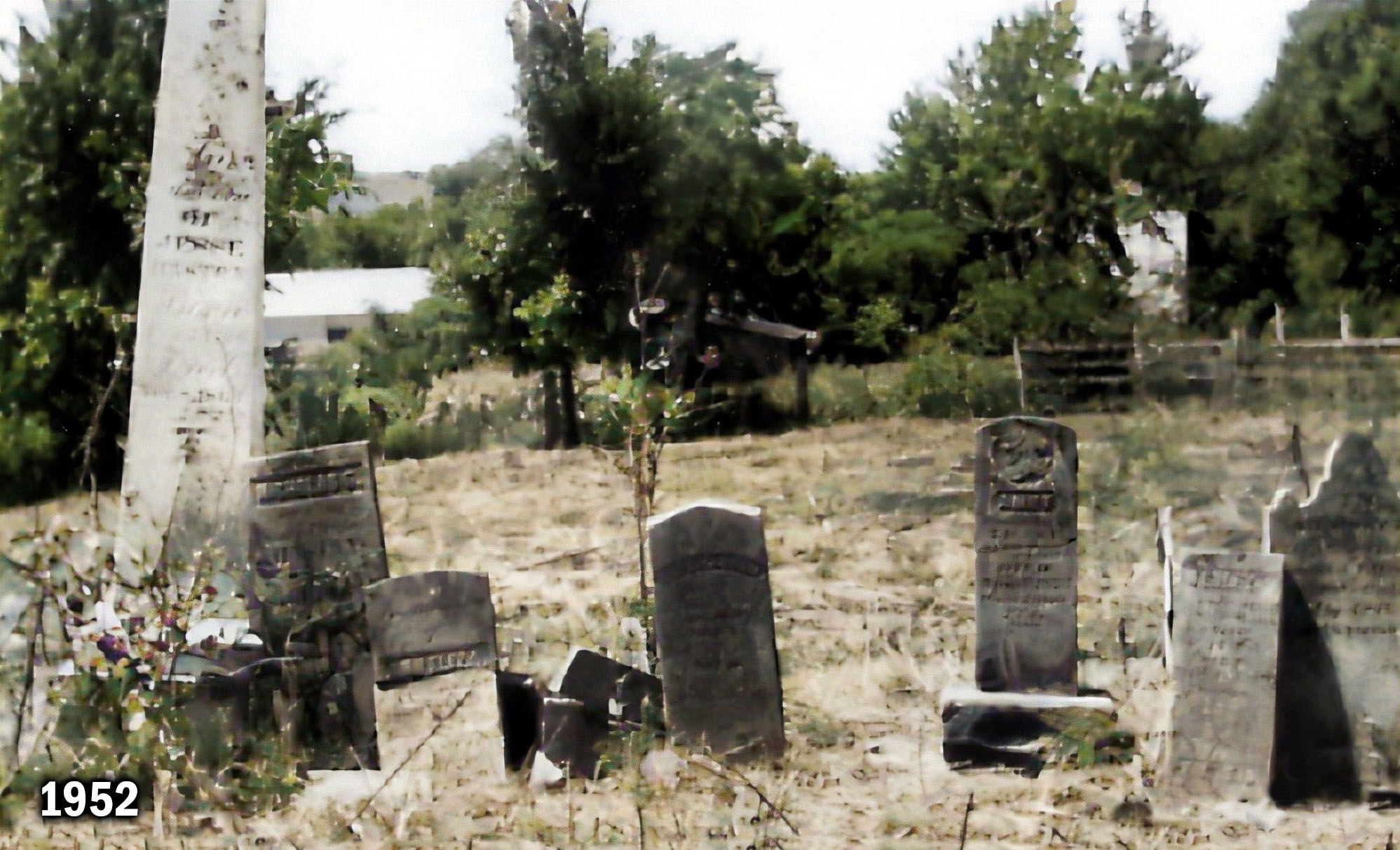

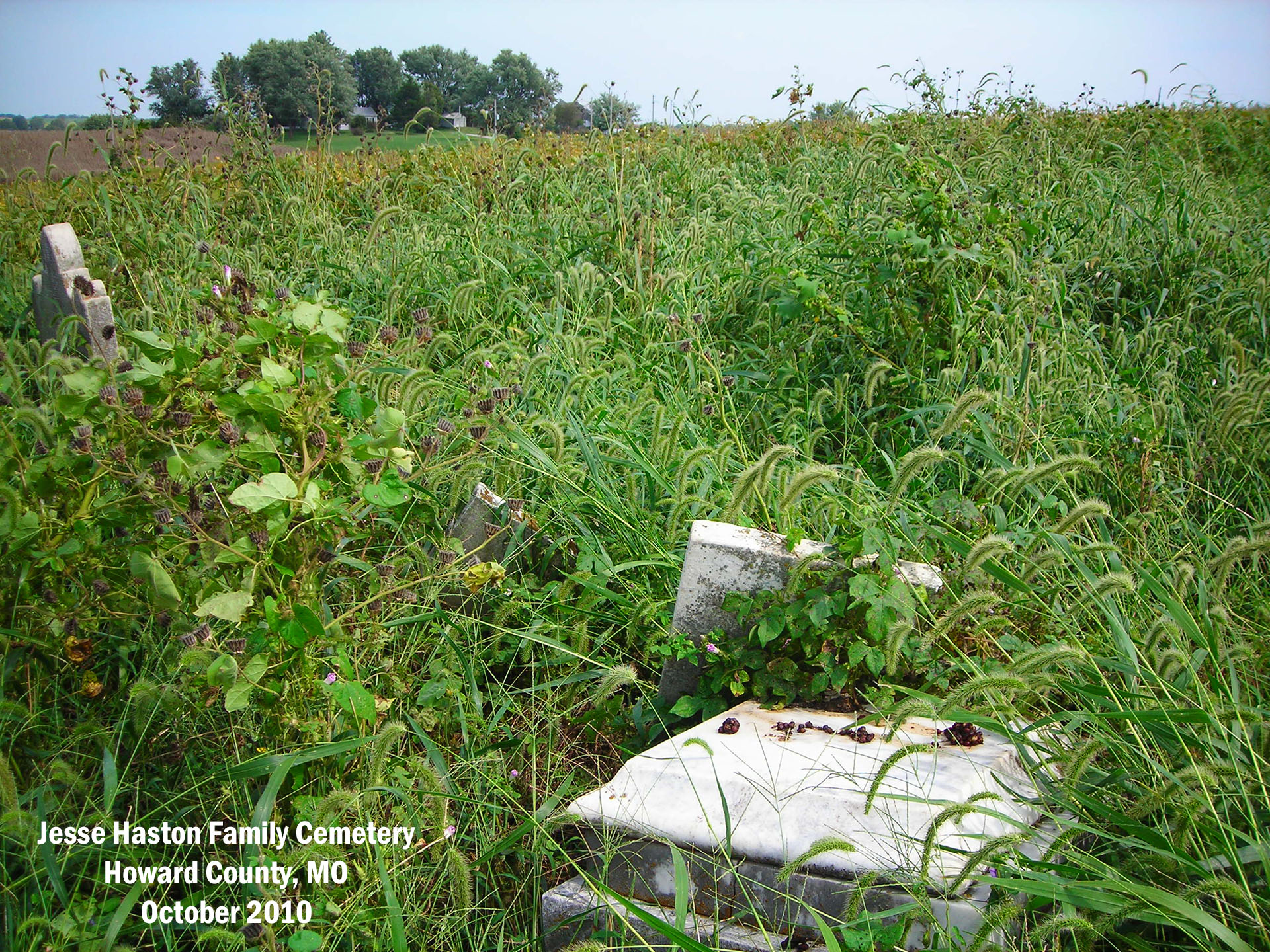
Second Wife: Susan M. Caroline White
Fall of 1847 – With a house full of kids and no mother around for them, Jesse married Susan M. Catherine White. Susan had previously been married to a Mr. White.* She was born July 14, 1809. According to the 1850 census, Susan’s birth occurred in Virginia. A 10-year-old boy, Thomas White, was part of the household at the time of the 1850 census but had not attended school in the previous year, as Jesse’s school-age children had done. Jesse and Susan had three children together, all of which died very young.
Child | Birth | Death |
Richard O. Haston | August 1, 1848 | March 21, 1850 |
Wesley Wilber Haston | August 12, 1849 | April 11, 1850 |
Unnamed infant |
|
|
Before 1850 – Jesse built this house near Glasgow, Missouri sometime before 1850. He lived there until his death and no doubt died there. The house stood until sometime after 2003.

March 9, 1852 – Jesse’s wife, Catherine M.,* died,[i] possibly while giving birth to the unnamed infant, her third child—none of which lived out of infancy. She and her children are buried in the Haston Cemetery on what was Jesse’s farm.
[i] Glasgow Weekly Times (Glasgow, Missouri), March 11, 1852, 2.

Third Wife: Annie Juliet Barnes
February 16, 1854 – Jesse married Annie J. (Juliet) Barnes, who was 21 years old and 36 years younger than Jesse.[i] In 1850, Jesse’s future (third) wife was only 18 years old and living with her parents in Carroll County, Missouri, approximately 60 miles northwest of where Jesse lived.
[i] “Married,” Glasgow Weekly Times (Glasgow, Missouri), February 23, 1854, 2.

In their marriage announcement, Jesse is referred to as “Capt. Jesse Haston.” A couple of his children’s obituaries also refer to him as “Captain.” Apparently, he was or had been a militia captain, a position that was elected by members of the group. Or maybe the title was an honorary one bestowed on him by friends and neighbors—which sometimes happened.
Annie Barnes, the daughter of Steward W. and Anne Barnes, was born in Maryland on February 5, 1832. Jesse had several living children that were older than his new (1832-born) wife. Even at age 57, Jesse was still “making babies”—five of them in the next 10 years and four months. He was 68 years and 10 months old when Annie, his last child, was born.
Child | Birth | Death |
Ann Elizabeth Haston | December 1, 1855 | |
Kate Haston | July 9, 1857 | December 27, 1875 |
Ida Lutia Haston | July 21, 1859 | December 7, 1926 |
Lillian Haston | August 20, 1861 | November 2, 1946 |
Any (Annie)* Haston | June 2, 1864 | May 8, 1936 |
March 8, 1855 – Miss Amanda M. Haston, daughter of Jesse and Elizabeth, married Dr. John H. Barnes of Columbia, Missouri.[i]
John was the six-year-older brother of Amanda’s stepmother, Annie Juliet Barnes Haston. At age 24, he was a dentist, as per the 1850 census.[ii] That explains the Dr. prefix to his name. Imagine this: His stepmother-in-law was his younger sister!
[i] “Married,” Glasgow Weekly Times (Glasgow, Missouri), March 15, 1855, 3; Howard County, Missouri Marriage Book 3, 246.
[ii] Year: 1850; Census Place: District 15, Carroll, Missouri; Roll: 395; Page: 16b.


Missouri was one of the 17 states, plus the District of Columbia, for which a “Slave Schedule” was enumerated as an auxiliary to the 1860 Federal Census.
Jesse owned twelve slaves, which apparently were kept in two slave houses. Two of his young slaves—both age 6 female mulattoes—were fugitives from the state.[i] These 12 slaves were probably considered to be part of Jesse’s $17,000 of personal property. Louise Haston Rice told me in 2010 that when the house Jesse built prior to the Civil War was torn down sometime after 2003, chains and shackles were found in the basement of the old house. I suppose those were for uncooperative slaves.
[i] The National Archives in Washington DC; Washington DC, USA; Eighth Census of the United States 1860; Series Number: M653; Record Group: Records of the Bureau of the Census; Record Group Number: 29.
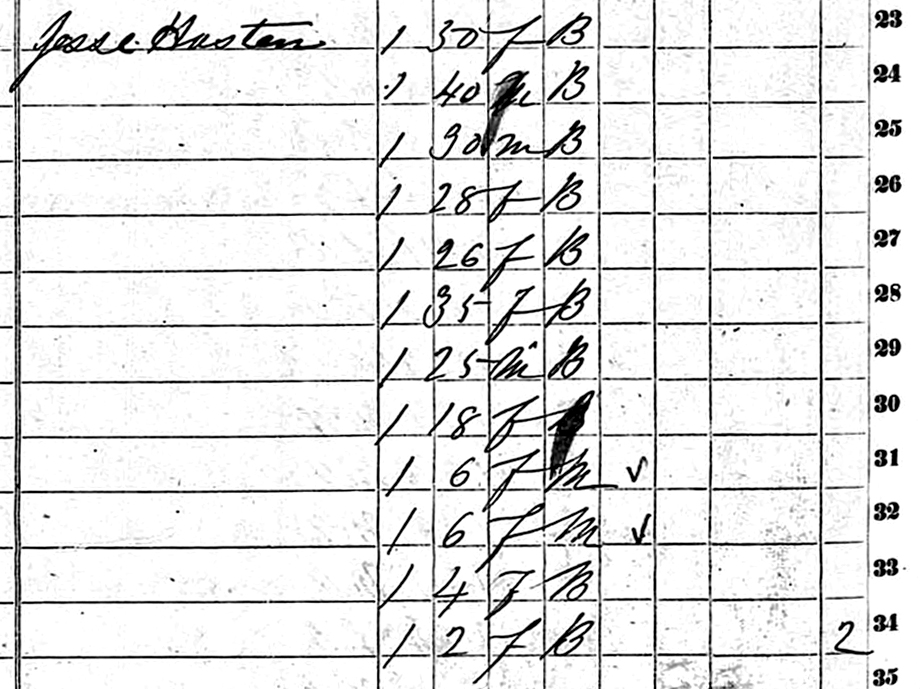
Jesse was the only son of Daniel Haston who was a slaveholder. If Daniel had lived long enough to know his son owned slaves, I think he would not have been pleased with Jesse.


In the following article (#48), you will learn about some significant happenings in the Jesse Haston family: his death by an ambusher’s bullets, some of his sons’ involvement in the Civil War, an attempted sexual assault on his youngest daughter, her brother’s attempt to kill the assailant, his grandson who received a Congressional Medal of Honor, and more.
If you appreciated this article, please share it with others who might also enjoy it.

